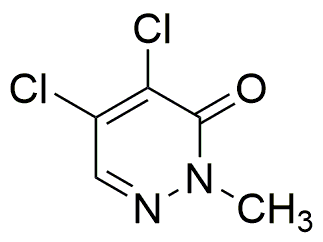4,5-Dichloro-2-methyl-3(2H)-pyridazinone is widely utilized in research focused on:
- Agricultural Chemicals: This compound serves as a key ingredient in herbicides, helping to control unwanted plant growth effectively while minimizing harm to crops.
- Pharmaceutical Development: It is explored for its potential in developing new medications, particularly in targeting specific diseases due to its unique chemical structure.
- Analytical Chemistry: Used as a standard reference material in laboratories, it aids in the calibration of instruments and validation of analytical methods.
- Material Science: This chemical is investigated for its properties in creating advanced materials, contributing to innovations in coatings and polymers.
- Environmental Studies: It plays a role in research assessing the impact of chemical pollutants, helping scientists understand and mitigate environmental risks.
Informations générales
Propriétés
Sécurité et réglementation
Applications
4,5-Dichloro-2-methyl-3(2H)-pyridazinone is widely utilized in research focused on:
- Agricultural Chemicals: This compound serves as a key ingredient in herbicides, helping to control unwanted plant growth effectively while minimizing harm to crops.
- Pharmaceutical Development: It is explored for its potential in developing new medications, particularly in targeting specific diseases due to its unique chemical structure.
- Analytical Chemistry: Used as a standard reference material in laboratories, it aids in the calibration of instruments and validation of analytical methods.
- Material Science: This chemical is investigated for its properties in creating advanced materials, contributing to innovations in coatings and polymers.
- Environmental Studies: It plays a role in research assessing the impact of chemical pollutants, helping scientists understand and mitigate environmental risks.
Documents
Fiches de données de sécurité (FDS)
La FDS fournit des informations de sécurité complètes sur la manipulation, le stockage et l’élimination du produit.
Spécifications du produit (PS)
Le PS fournit une description complète des propriétés du produit, notamment sa composition chimique, son état physique, sa pureté et les exigences de stockage. Il détaille également les plages de qualité acceptables et les applications prévues du produit.
Certificats d'analyse (COA)
Recherchez des certificats d'analyse (COA) en saisissant le numéro de lot du produit. Les numéros de lot et de lot se trouvent sur l'étiquette d'un produit, après les mots « Lot » ou « Lot de fabrication ».
Numéro de catalogue
Numéro de lot/série
Certificats d'origine (COO)
Ce certificat d'exploitation confirme le pays dans lequel le produit a été fabriqué, et détaille également les matériaux et composants utilisés et s'il est issu de sources naturelles, synthétiques ou autres sources spécifiques. Ce certificat peut être requis pour les douanes, le commerce et la conformité réglementaire.
Numéro de catalogue
Numéro de lot/série
Fiches de données de sécurité (FDS)
La FDS fournit des informations de sécurité complètes sur la manipulation, le stockage et l’élimination du produit.
DownloadSpécifications du produit (PS)
Le PS fournit une description complète des propriétés du produit, notamment sa composition chimique, son état physique, sa pureté et les exigences de stockage. Il détaille également les plages de qualité acceptables et les applications prévues du produit.
DownloadCertificats d'analyse (COA)
Recherchez des certificats d'analyse (COA) en saisissant le numéro de lot du produit. Les numéros de lot et de lot se trouvent sur l'étiquette d'un produit, après les mots « Lot » ou « Lot de fabrication ».
Numéro de catalogue
Numéro de lot/série
Certificats d'origine (COO)
Ce certificat d'exploitation confirme le pays dans lequel le produit a été fabriqué, et détaille également les matériaux et composants utilisés et s'il est issu de sources naturelles, synthétiques ou autres sources spécifiques. Ce certificat peut être requis pour les douanes, le commerce et la conformité réglementaire.


